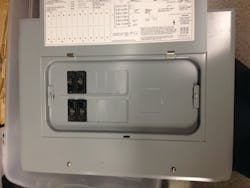I was speaking with a work colleague who happens to be a firefighter about specific uses for thermal imagers (TIs). Our conversation turned toward a topic that we both felt deserved discussion.
One of the most challenging fire conditions to control is the one we don’t see. Sometimes, the “red devil” is lurking out of plain sight complicating the process of detection, containment and suppression. Signs of concealed fire location can often be obvious, manifesting in such ways as blistering paint, smoke emitting from a wall or cracking sounds from combustion. Yet, other times, the incipient stage and smaller fire may not yield strong clues as to its exact location within the structure.
Locating abnormal heat
When searching the interior of a structure to locate hidden fire, the use of a TI can expedite the task. Using a typical house fire as an example, scanning the interior wall and ceiling surfaces for signs of abnormal heat from a distance of at least 10 to 15 feet provides a broad perspective of possible hidden heat conditions. Most fire service thermal imagers can focus when viewing objects of three or more feet away from a surface, so maintaining this distance from the surface will yield better results.
In attempting to locate hidden fire with the aid of a TI, firefighters should look for anomalies in the thermal signature of surfaces that cannot be explained by other ordinary heat sources. To distinguish abnormal from normal, firefighters should consider what ordinary heat sources could be and how they may be impacting thermal signatures. Examples include a working appliance on the other side of the wall, active heat ducts inside the wall or outside sunlight affecting the area and warming it.
The shape of the thermal anomaly is also important. One with perfectly straight sides suggests a heat source located between studs of some other structural component. A change in the shape, particularly vertical growth, suggests intensification of the void space fire. One of the key usage points with a TI is the idea of relative thermal comparison of the area being investigated. When investigating, firefighters can compare the area being viewed in conjunction with other areas.
Concealed- or void-space fires often involve electrical circuits or equipment. TIs are useful for performing a thermal scan on an electrical distribution panel to see if a particular circuit is showing a relatively greater heat signature when compared to others. While this does not necessarily indicate a problem, it is additional information that can be used in investigations.
As a cautionary note, my colleague related to me a recent fire department response to an automatic fire alarm in a bank building. A member of the first-arriving engine scanned the interior walls with a TI and noticed a warm spot on one wall. The officer decided to open up the wall, only to find a water heater on the other side. A quick look behind the adjacent door might have prevented unnecessary damage.
Thermal imagers are also useful in detecting hidden fires from an exterior of a structure. Thermal signatures that seem abnormal or out of place can indicate a hidden problem. However, environmental conditions can make accurate determinations more challenging. For example, in bright daylight solar loading on an exterior wall can often look to the TI like a problem area when there is none. Other times, solar loading can mask or disguise a real issue. Similarly, multiple layers of a built-up roof can help hide the location of concealed fires underneath. Again, firefighters should use thorough investigative techniques to confirm information provided by the TI. These concepts also apply to overhaul. A thorough look with a TI can pinpoint hot spots, helping to avoid a rekindle.
The TI is just one more tool to help locate and control fires in void spaces. Understanding what the image on the TI means is key to making your job more efficient and safer.

John Hays
JOHN HAYS is the Product Line Manager for Emergency Responders at Bullard. He has spent more than 13 years developing emergency responder products for the fire, rescue and police markets. Hays’ technical expertise in developing emergency responder products has been instrumental in advancing the use of thermal imagers in the fire service. If you have questions about thermal imaging, you can email him at [email protected].






